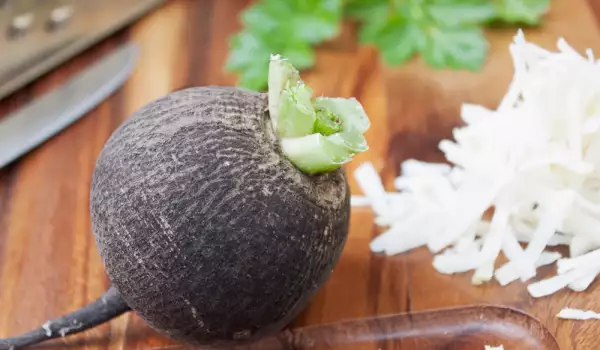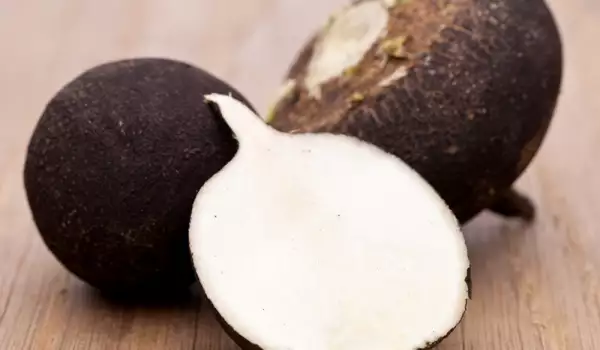The black radish (Raphanus sativus niger) is a biannual root plant, which forms a leaf rosette and root in the first year and a flowering stem in the second. The black radish is common in many areas of Europe and Asia (especially Korea, China and Japan). Along with white radish, it is a characteristic crop among these regions.
The black radish is distinguished by its large spherical root, which is quite dark, nearly black, reaching up to 8″ (20 cm). The inner part is whitish to yellowish, with a strong acrid taste and specific fragrance. The flowering stem of a black radish reaches up to 3.5 ft (1 m) in height. The black radish blooms with white flowers but some varieties may contain other colors as well.
Composition of Black Radish
This crop has a rich chemical composition. It is a source of vitamin A, vitamin B2, vitamin C, vitamin P and vitamin K. This root vegetable contains calcium, potassium, magnesium, phosphorous and more. Black radishes are a source of glycosides, pectin and other substances.
Growing Black Radish
Black radish is among the cold resistant varieties. In general, it handles cold easily but if the chill is extreme, it can split before it has formed a root. That is why agriculturists point to temperatures of 60°F (17°C) as the most favorable for the development of this crop.
Black radish loves light so when planting it avoid areas that are too shadowy in your garden. This type of radish is also choosey when it comes to soil - loose soils rich in nutrients are preferred. The richer the soil, the greater the chance for an abundant harvest. If the soils are poor, there is a serious risk for the root to remain small.
When growing black radish it is also recommended to fertilize the plant. If you have animal manure you can use it without a problem. Droughts do not have a good effect on black radishes, so it is advised to water them regularly during the vegetative state, which lasts about 3 months.
Agriculturalists note that the best results can be seen with drip watering. Black radishes are also used as secondary crops at times. The seeds are planted in rows at the end of the summer. Once 2 actual leaves appear, the plants need to be thinned. The roots can be taken out at the beginning of November.
Selection and Storage of Black Radish
If you've grown your own black radish, you can pick it shortly before winter sets in. The harvest needs to be stored in a cool and dark place. It is recommend placing the root in moist sand so that it remains fit for consumption for at least 2 months. If you desire, you can store the radish in the refrigerator. To do so simply wrap it in plastic wrap and put it in a separate compartment. In the fridge it will remain fresh for about a month.
If you do not possess the right conditions to grow black radishes at home, you can buy some from the store. When picking out these types of radishes you shouldn't look for large ones because they may have a bitter taste. Look for medium-sized radishes that do not have any external bruising. When touched, a fresh radish is firm and does not give off an unpleasant aroma.

Cooking Black Radish
Black radishes are used in Asian cuisine and elsewhere. Even though it can be heat treated, it is considered best to consume it fresh. But it must be noted that it is used in soups and sauteed dishes. It needs to be peeled from the black rind and cut into thin slices or grated.
Chopped raw black radish is a component of favorite salads where it is combined with beets, cabbage, carrots, celery, peppers, potatoes, tomatoes, corn, olives, parsley, dill, garlic. Rarely on occasion, some chefs add boiled eggs to their radish salads. Black radish salads are seasoned with vinegar or lemon juice. Mayonnaise and yoghurt make for a nice finish.
Besides in salads, the radishes can be included in mixed pickles with cauliflower, gherkins, green tomatoes, carrots and bell peppers.
Benefits of Black Radish
The health benefits of the black radish have been known for some time. This root vegetable is used as an appetite stimulant, as a cholagogue and to treat kidney stones. Studies have shown that black radishes improve digestive system function, strengthen the immune system and have anti-flu an action.
The crushed seeds of this type of radish are used as an antimicrobial agent. Black radish juice, on the other hand, is drunk for sore throat. In addition, black radish cleanses the liver and protects it from the negative impact of harmful substances.
Another positive aspect of the black radish is that it can stabilize high blood pressure. Scientists reached this conclusion after carrying out a study with 120 people who were suffering from hypertension. The experiment showed that after eating black radishes their blood pressure levels dropped significantly.
Folk Medicine with Black Radish
Folk medicine recommends black radishes especially for stubborn cough and lung problems. Cut the root vegetable and carve out the insides. Put in sugar and wait until a syrup forms. Take several teaspoons of the liquid each day until the unpleasant symptoms vanish.



















